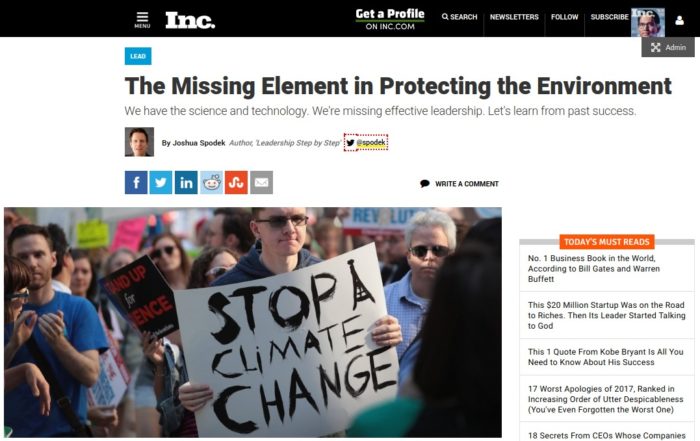The Missing Element in Protecting the Environment
We have the science and technology. We’re missing effective leadership. Let’s learn from past success.

Who would expect an insight on how to protect the environment to come from hookworms?
I recently saw Zia Khan, the Rockefeller Foundation’s Vice President of Initiatives and Strategy, speak at the New York Academy of Science‘s Summit on United Nations Strategic Goals. That’s a high-level group of organizations and people.
He didn’t speak on the environment, but the project he worked on showed something missing from climate change work, at least that I don’t see.
He talked about hookworms, hookworm disease, and how a 1909 program nearly eradicated it in the American south. For the details of the disease, it’s enough to know hookworms are a parasite that sap your blood and strength. You don’t want it.
By 1909 we knew how to cure and prevent it. It takes medication, education, and field work. The challenge was implementation. You have to stop people from defecating outdoors, which is how the worms spread, and start wearing shoes, among other changes.
According to Dr. Khan, southerners didn’t immediately welcome northerners telling them what to do shortly after the Civil War. All the medication and education in the world doesn’t help if people don’t trust or believe you. Hence the field work.
What worked then
According to Dr. Kahn,
They recognized that it wasn’t just about medical cures, but also about communities and government.
Southerners initially distrusted these early efforts. Many took offense at what they perceived to be accusations of infection. Regional newspapers initially criticized the efforts. But in just one year public opinion turned in favor of the campaign. Commission staff innovated in their outreach, using demonstrations, illustrated lectures, and some of the very first movie public service announcements. After five years, the campaign was deemed to have been a success and the commission was disbanded. Not only were incidents of hookworm infection greatly reduced, the campaign was also a great contribution to creating public health institutions in many Southern states.
Note the human side to the campaign–a bedside manner beyond the science and facts.
Imagine northern doctors coming down to the southerners just telling them to stop what they were doing, saying that they had all the answers, talking down to them, and disparaging their habits.
Even if they were right and meant well, they would have provoked resistance and likely failed.
What’s missing today
Now look at the protester in the picture above. I don’t know all his environmental positions, but I bet we share similar goals of clean air, land, and water.
But how exactly do I follow his instructions of stopping climate change?
Or consider any nature shows you’ve seen. Did they show some beautiful natural landscape being destroyed or at risk of it? Or the same for some species? And did they fly there to get the footage?
I agree with conservation, but isn’t there an element of do-as-I-say-not-as-I-do? Besides, what exactly do I do to prevent landscape loss?
Isn’t there something positive people can do? Where is the bedside manner?
I believe we can apply what worked with hookworm: go to the communities we want to influence, enter their world, and instead of telling them what to do, enter their world.
Act more with empathy and less instruction. Instead of seeking compliance, seek to motivate and inspire.
If scientists and activists want you to drive and fly less, I think they’ll do better by showing that you can enjoy life more driving and flying less. I’ve found living by my environmental values greatly improved my life.
That’s what value means–determining better and worse, which enables you to choose and live a better life.
In this column I’ve shared how much my experiment not flying has improved my life, which I say as someone with family all over and work that I used to think required flying.
Two successful examples
Much environmentalism today is like northerners telling southerners what to do, but not all. Two examples go against that trend, and I believe they will set the tone of what works.
First, the podcast I started last month, Leadership and the Environment, invites top influencers to share their environmental values and live by them–not tell people what to do. Too many people are already telling people what to do.
Guests share their stories of their challenges–their struggles and triumphs. Nearly all share that they wish they had changed earlier. They all faced challenges, but they were glad they did.
When you think of using less energy, buying less stuff, and so on, you probably think of what you’ll miss. These guests, who include luminaries like Dan Pink, Elizabeth Kolbert, and Marshall Goldsmith, show through their behavior what you gain.
Second, Generation 180, a nonprofit that helps people reduce energy waste and consumption, creates tools to help people change their behavior. They go out in the field and work with people who want to change but don’t know how.
I love this video they created. Compared to many protests and people telling people what to do, it reminds me of what Zia Khan said worked in 1909. It speaks the language of the communities it serves. Sure, it’s backed by science and engineering, but effective leadership emerges from empathy with those you want to lead and speaking their language.
I consider efforts that show that what works improves your life and community more effective than telling people what to do or not, or showing damage without a way out.
Science is essential, to guide leadership
Science and engineering are necessary, but when it comes time to lead, use what works, such as empathy, field work, compassion, meeting people where they are, and living consistently by your values, with integrity.
